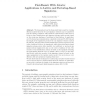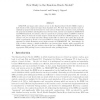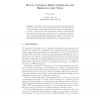324 search results - page 21 / 65 » A new signature scheme without random oracles |
ASIACRYPT
2009
Springer
14 years 2 months ago
2009
Springer
We demonstrate how the framework that is used for creating efficient number-theoretic ID and signature schemes can be transferred into the setting of lattices. This results in cons...
CRYPTO
2009
Springer
14 years 2 months ago
2009
Springer
RSA-FDH and many other schemes secure in the Random-Oracle Model (ROM) require a hash function with output size larger than standard sizes. We show that the random-oracle instanti...
CRYPTO
2004
Springer
14 years 24 days ago
2004
Springer
Ordinarily, RSA and Rabin ciphertexts and signatures are log N bits, where N is a composite modulus; here, we describe how to “compress” Rabin ciphertexts and signatures (among...
CRYPTO
2000
Springer
13 years 11 months ago
2000
Springer
Abstract. The Full Domain Hash (FDH) scheme is a RSA-based signature scheme in which the message is hashed onto the full domain of the RSA function. The FDH scheme is provably secu...
ICICS
2005
Springer
14 years 27 days ago
2005
Springer
The notion of concurrent signatures was recently introduced by Chen, Kudla and Paterson. In concurrent signature schemes, two entities can produce two signatures that are not bindi...



